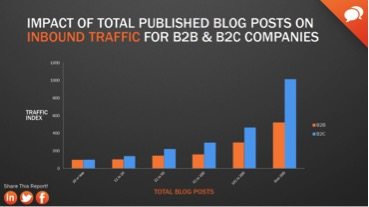“Content is king,” said Microsoft founder Bill Gates back in 1996. He of course was referring to the importance of content as both a traffic driver and lead generator. But what’s amazing is how accurate this statement remains 20 years later. If anything, content is becoming more paramount to a brand’s success than ever before, and it’s causing businesses to work harder at coming up with a content marketing strategy. It’s no longer enough to produce a few random pieces of content then walk away. Positive results are procured through trial, testing, spotting errors, and optimizing for better outcomes. This rinse and repeat process may sound tedious, but it will inevitably drive more quality traffic to your website.
Importance of Content as a Traffic Driver
Businesses are noticing that content marketing costs 62% less than traditional marketing practices, and generates nearly 3 times as many leads. As Hubspot found in their benchmark study of 7,000 customers, the more content you create the more traffic you receive.

Of course, not all content is created equal but your content doesn’t have to be over the top or a huge financial investment. It may consist of a blog, a how-to video, or an announcement about a product launch. The point is to disseminate regular information and allow nature to take its course. What do we mean by that?
Each time you post new content, you are improving your site’s SEO. Google’s algorithm will reward you by boosting your search engine ranking position (SERP). From there, your content will become more visible, and other bloggers, influencers and publishing platforms will link to your website. Since content is the #2 signal in Google’s algorithm and inbound links is #1, it’s important to produce content with shareability in mind. Think of it as a way for customers to tell their friends about your insight and expertise and for Google to take notice.
Performing a Content Audit
History is the best predictor of the future so one way to optimize your content, is to figure out how it performed in the past. A content audit begins by organizing all of your website’s content into a spreadsheet, and measuring its success next to a set of predefined metrics. Collecting all of this data can be time consuming, but there are crawlers, like Screaming Frog, that organize and collate your links into a more manageable workflow.

Questions you’ll be looking to solve include: How much organic search traffic does each web page receive per month? What is the bounce rate for search traffic versus social traffic? How long does each user spend per page? Does content type (article, video, podcast, etc.) make a difference? How does publishing time and date and the promotion channels I pursue effect the content’s performance? This data can be easily be gathered from Google Analytics and other digital marketing tools.
Two Metrics to Measure Traffic
Pageviews and bounce rates are two of the top methods to gauge content effectiveness, so let’s delve deeper. Since 73 percent of marketers identify brand awareness as a goal of their content, let’s focus on engagement time and returning visitors. People who spend longer on our website, versus those who leave without visiting a second page (e.g. bounce rate) are genuinely interested in what we have to say and more likely to share your content, opt into your email or purchase your product or service.

Unfortunately, conversions don’t happen right away. According to Salesforce, it can take 6 to 8 touch points just to generate a sales lead. How do you increase engagements and repeat visitors? Content brings people back. Content leads to credibility, and if your expertise was helpful once there’s no reason your customers won’t continue to see you as a resource. When they return to your site, they’re exhibiting a real passion for the brand that will eventually benefit your bottom line if you continue to invest in the relationship with compelling and creative content.
Content Is Evolutionary
To make your content sticky, you must test, measure, and test again. All the while, you should be continually posting new content not only for SEO, but engaging and educating your audience. If you truly subscribe to the ‘content is king’ ethos, and you should, then understanding what content is most important to your customers should inform your content planning, production and promotion.
Infographic by Marccx.com


